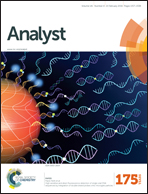Carbon nanotubes implanted manganese-based MOFs for simultaneous detection of biomolecules in body fluids†
Abstract
Metal–organic frameworks (MOFs) have recently attracted much interest in electrochemical fields due to their controlled porosity, large internal surface area, and countless structural topologies. However, the direct application of single component MOFs is limited since they also exhibit poor electronic conductivity, low mechanical stability, and inferior electrocatalytic ability. To overcome these problems, we implanted multi-walled carbon nanotubes (MWCNTs) into manganese-based metal–organic frameworks (Mn-BDC) using a one-step solvothermal method and found that the introduction of MWCNTs can initiate the splitting of bulky Mn-BDC into thin layers. This splitting is highly significant in that it enhances the electronic conductivity and electrocatalytic ability of Mn-BDC. The constructed Mn-BDC@MWCNT composites were utilized as an electrode modifying material in the fabrication of an electrochemical sensor and then were used successfully for the determination of biomolecules in human body fluid. The sensor displayed successful detection performance with wide linear detection ranges (0.1–1150, 0.01–500, and 0.02–1100 μM for AA, DA and UA, respectively) and low limits of detection (0.01, 0.002, and 0.005 μM for AA, DA and UA, respectively); thus, this preliminary study presents an electrochemical biosensor constructed with a novel electrode modifying material that exhibits superior potential for the practical detection of AA, DA and UA in urine samples.


 Please wait while we load your content...
Please wait while we load your content...